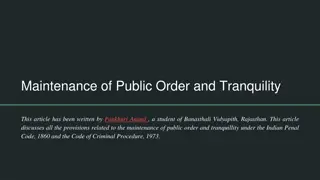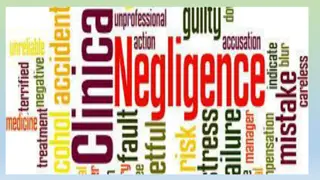Understanding Public Nuisance in Tort Law
Explore the concept of public nuisance in tort law, distinguishing it from private nuisance, understanding the legal implications, definitions, and key elements involved. Learn about the offences related to public nuisance, including mode of trial and civil remedies available. Gain insights into the impact on society and the legal responsibilities associated with public nuisances.
Download Presentation

Please find below an Image/Link to download the presentation.
The content on the website is provided AS IS for your information and personal use only. It may not be sold, licensed, or shared on other websites without obtaining consent from the author. Download presentation by click this link. If you encounter any issues during the download, it is possible that the publisher has removed the file from their server.
E N D
Presentation Transcript
Torts connected to land Public Nuisance
Learning Objectives: By the end of the session you should be able to: Define public nuisance Explain the main difference between public and private nuisance Explain the fault element for a public nuisance Explain a class of Her Majesty s subjects Explain the main criticisms of public nuisance Explain suggestions for reform Explain the bringing of civil actions for public nuisance Identify realtor actions for public nuisance Identify the specific defence to public nuisance Identify the main civil remedies to a public nuisance 1. 2. 3. 4. 5. 6. 7. 8. 9. 10.
Definition of a Public Nuisance A public nuisance is a nuisance which materially affects the reasonable comfort and convenience of life of a class of Her Majesty's subjects. Attorney-General v PYA Quarries Ltd [1958] per Romer LJ http://www.bailii.org/ew/cases/EWCA/Civ/1958/1.html
Archbolds Definition A person is guilty of a public nuisance (also known as common nuisance), who (a) does an act not warranted by law, or (b) omits to discharge a legal duty, if the effect of the act or omission is to endanger the life, health, property or comfort of the public, or to obstruct the public in the exercise or enjoyment of rights common to all Her Majesty s subjects. P. J. Richardson (ed), Archbold: Criminal Pleading, Evidence and Practice (2015) para 31-40
Difference with a Private Nuisance A public nuisance differs with a private nuisance on the basis of who is affected by the nuisance. A public nuisance affects a representative cross-section of a class of society in a neighbourhood.
Public Nuisance: A Crime A public nuisance is a crime.
Mode of Trial Under the Magistrates Courts Act 1980, s 17(1) and Sch 1, public nuisance is an offence which is triable either way. Triable either way means it can be tried in either a magistrates court or in the Crown Court.
The Fault Element There is no requirement of intention or recklessness in the offence of public nuisance; the fault element is one of foreseeability of the risk of the type of nuisance. The defendant is liable if he or she knew or ought to have known of the risk of the type or kind of nuisance that in fact occurred.
The Fault Element This type of foreseeability was established in Wagon Mound (No 1) and reiterated in Cambridge Water Co v Eastern Counties Leather PLC [1994]. It is the same type of foreseeability in private nuisance. [Please note that the term fault element is sometimes referred as the mens rea in criminal law.]
Foreseeability In R v Goldstein [2006], the defendant had enclosed some salt in an envelope together with a cheque. It was intended as a joke both because of the age of the debt he was paying and as a reference to a recent anthrax outbreak in the USA which he had recently discussed with the intended recipient of the envelope . The salt leaked out of the envelope in a Post Office sorting office creating an anthrax scare and the evacuation of the sorting office. The House of Lords held that there was no public nuisance because it was not proved that the defendant knew or reasonably should have known that the salt would escape from the envelope in the sorting office and cause a nuisance. https://www.publications.parliament.uk/pa/ld200506/ldjudgmt/jd051027/gol d-1.htm
Attorney-General v PYA Quarries Ltd [1958] An injunction was obtained to prevent the defendant from emitting quantities of stones, splinters dust and vibration from their quarry which was disturbing the local residents. The defendants unsuccessfully appealed to the Court of Appeal to have the injunction removed. The injunction was granted as the result of a relator action . This is when an injunction is sought to stop a person committing a public nuisance. Relator actions are brought in the name of the Attorney General. They are today very rare.
Affecting a Representative Cross-section of a Class of Society in a Neighbourhood Romer, LJ stated: The sphere of the nuisance may be described generally as "the neighbourhood"; but the question whether the local community within that sphere comprises a sufficient number of persons to constitute a class of the public is a question of fact in every case. It is not necessary, in my judgment, to prove that every member of the class has been injuriously affected; it is sufficient to show that a representative cross-section of the class has been so affected Attorney-General v PYA Quarries Ltd [1958] http://www.bailii.org/ew/cases/EWCA/Civ/1958/1.html
A Widespread and Indiscriminate Nuisance Denning, LJ stated: I decline to answer the question how many people are necessary to make up Her Majesty's subjects generally. I prefer to look to the reason of the thing and to say that a public nuisance is a nuisance which is so widespread in its range or so indiscriminate in its effect that it would not be reasonable to expect one person to take proceedings on his own responsibility to put a stop to it, but that it should be taken on the responsibility of the community at large. Attorney-General v PYA Quarries Ltd [1958] http://www.bailii.org/ew/cases/EWCA/Civ/1958/1.html
A Class of People The facts of the case will determine if the persons affected by a nuisance amount to a class of people.
Class of People: Local Communities In R v Ruffell (1991) the defendant had pleaded guilty to causing a public nuisance. The nuisance had consisted of an "acid house" party. A side road to the site had been blocked by traffic. There had been very loud music playing all night. The woodlands around the site had been littered with human excrement. The class of people affected by the nuisance were the local residents. The defendant unsuccessfully appealed to the Court of Appeal against the custodial sentence imposed in the Crown Court.
Class of People: Group with a Common Interest In R v Ong [2001] the defendant and others were planning to interfere with the floodlights in the course of the Premier Division match between Charlton Athletic and Liverpool football teams. They pleaded guilty to conspiracy to commit a public nuisance (and another offence). The class of people that would have been affected by the nuisance were the football spectators. The defendants unsuccessfully appealed to the Court of Appeal against the custodial sentences imposed in the Crown Court.
Class of People: Impact on the Community In R v Lowrie [2004] the defendant who had made a number of hoax calls to the emergency services pleaded guilty to causing a public nuisance. He appealed unsuccessfully to the Court of Appeal against the custodial sentence imposed. The class of people that would have been affected by the nuisance were those people who were in genuine need of help by the emergency services but could not get help because the emergency services had been diverted elsewhere by the hoax calls. http://www.bailii.org/ew/cases/EWCA/Crim/2004/2325.html
Sending Abusive Letters In R v Rimmington [2006] the House of Lords held that sending racially offensive materials to members of the public was not a public nuisance. Their reasoning was that sending individual letters to individual people did not constitute a nuisance affecting a class of people. The House of Lords also stated that common law offences such as public nuisance should not be used for conduct covered by a statutory offence unless there was a good reason. Rimmington could have been prosecuted under the Malicious Communications Act 1988. https://www.publications.parliament.uk/pa/ld200506/ldjudgm t/jd051027/gold-1.htm
Making Obscene Telephone Calls In R v Johnson [1997] the Court of Appeal held that making obscene telephone calls to a number of women in a geographic areas was a public nuisance. However, the House of Lords indicated in R v Rimmington [2006] that such behaviour is unlikely to amount to a public nuisance as they were separate calls made to separate people rather than to a class of people. Making obscene telephone calls can now be prosecuted under statutory provisions such as the Communications Act 2003.
Law Commission Report No 358 The Law Commission indicated in 2015 that Prosecutions for public nuisance were still occurring despite the presence of relevant statutory provisions 1. Some nuisance telephone call cases were still being prosecuted as a public nuisance. 2. Both of the above indicate that limitations on prosecution imposed Rimmington were not being reflected in practice .
Public Nuisance: Activity Please read the following: Law Commission, Simplification of Criminal Law: Public Nuisance and Outraging Public Decency (Law Com No 358, 2015) http://www.lawcom.gov.uk/wp- content/uploads/2015/06/lc358_public_nuisance.pdf You need only read the parts concerning public nuisance. You will find that the report gives a good insight into public nuisance.
Public Nuisance: Questions What criticisms does the Law Commission make of the law on public nuisance? How does the Law Commission suggest that the law on public nuisance could be reformed?
Civil Actions Against Public Nuisance Civil actions can be brought against those committing a public nuisance in three ways. The remedies sought will be damages and an prohibitory injunction. By a relator action. These are brought in the name of the Attorney General on behalf of a private citizen who has persuaded the Attorney General to agree to the action. Such actions are rare. 1. By a local authority under the Local Government Act 1972 s.222. 2. An action for tort by a private citizen who can show that he has suffered special damage beyond that experienced by the others of Her Majesty s subjects . 3.
Relator Actions Relator actions for public nuisance are very rare. Possible reasons for this include: There are statutory bodies such as local authorities who will usually bring the actions. The Attorney General is unlikely to agree to a relator action unless there is special damage and, if there is special damage, private citizens can bring actions in their own name without the permission of the Attorney General. Most nuisance which the affects the citizen can be prosecuted under statutory provisions rather than public nuisance. It is often the case that the Attorney General will receive no applications for a realtor action in one particular year. 1. 2. 3.
Specific Remedy for Public Nuisance In addition to the general defences to tort (please see the separate presentation for these), statutory authority is the main specific defence to public nuisance. This means that the alleged nuisance is permitted by statute. Prescription cannot be used as a defence to a charge of public nuisance.
Civil Remedies for Public Nuisance The main civil remedies for public nuisance are damages and injunctions. Please see the separate presentation for these.























